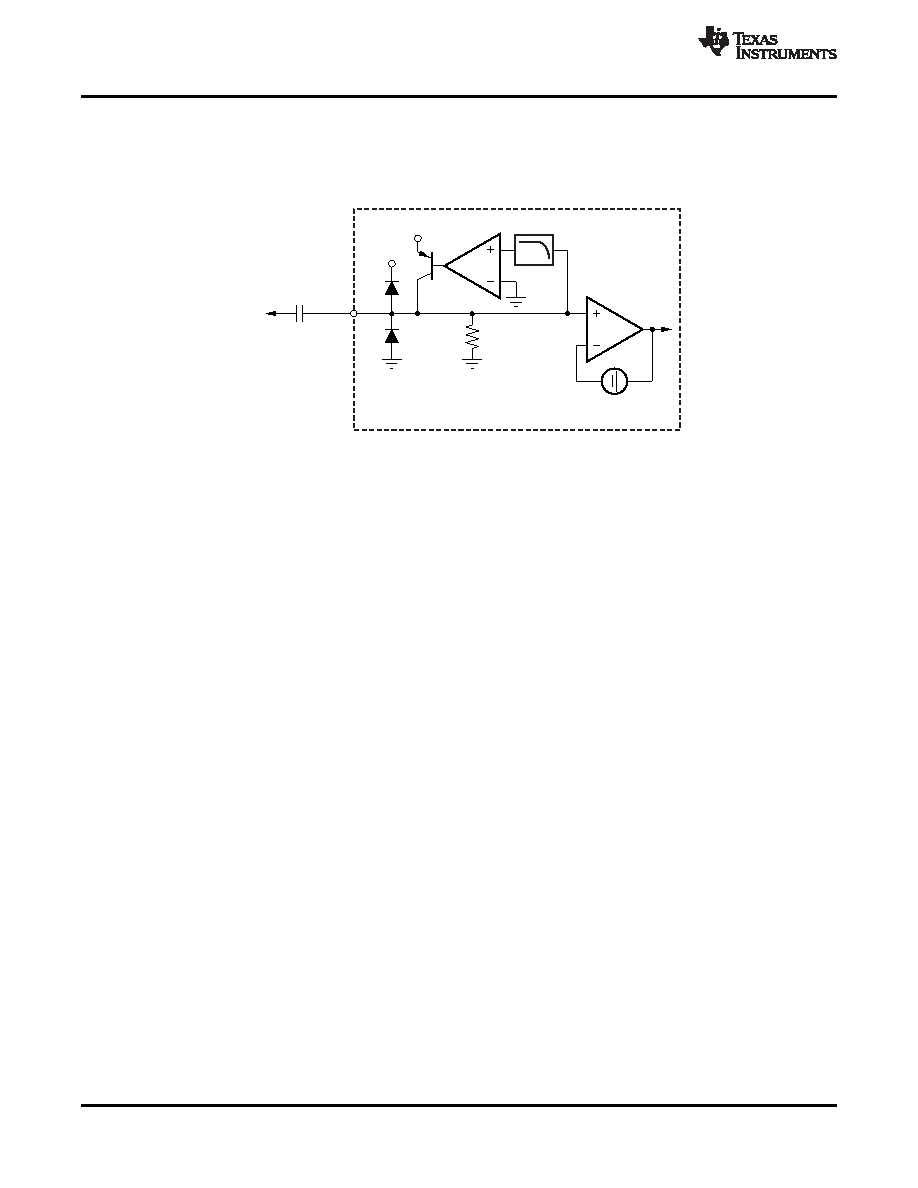- 您現(xiàn)在的位置:買賣IC網(wǎng) > PDF目錄98229 > THS7372IPW (TEXAS INSTRUMENTS INC) 4 CHANNEL, VIDEO AMPLIFIER, PDSO14 PDF資料下載
參數(shù)資料
| 型號: | THS7372IPW |
| 廠商: | TEXAS INSTRUMENTS INC |
| 元件分類: | 音頻/視頻放大 |
| 英文描述: | 4 CHANNEL, VIDEO AMPLIFIER, PDSO14 |
| 封裝: | GREEN, PLASTIC, TSSOP-14 |
| 文件頁數(shù): | 26/49頁 |
| 文件大小: | 1768K |
| 代理商: | THS7372IPW |
第1頁第2頁第3頁第4頁第5頁第6頁第7頁第8頁第9頁第10頁第11頁第12頁第13頁第14頁第15頁第16頁第17頁第18頁第19頁第20頁第21頁第22頁第23頁第24頁第25頁當(dāng)前第26頁第27頁第28頁第29頁第30頁第31頁第32頁第33頁第34頁第35頁第36頁第37頁第38頁第39頁第40頁第41頁第42頁第43頁第44頁第45頁第46頁第47頁第48頁第49頁

Level
Shift
Internal
Circuitry
+V
S
800kW
Input
Pin
Input
0.1 mF
g
m
+V
S
STCLPF
SBOS578
– AUGUST 2011
To help minimize this input signal overshoot problem, the control loop in the THS7372 has an internal low-pass
filter, as shown in Figure 86. This filter reduces the response time of the STC circuit. This delay is a function of
how far the voltage is below ground, but in general it is approximately a 400-ns delay for the SD channel filters
and approximately a 150-ns delay for the FHD filters. The effect of this filter is to slow down the response of the
control loop so as not to clamp on the input overshoot voltage but rather the flat portion of the sync signal.
Figure 86. Equivalent AC Sync-Tip-Clamp Input Circuit
As a result of this delay, sync may have an apparent voltage shift. The amount of shift depends on the amount of
droop in the signal as dictated by the input capacitor and the STC current flow. Because sync is used primarily
for timing purposes with syncing occurring on the edge of the sync signal, this shift is transparent in most
systems.
While this feature may not fully eliminate overshoot issues on the input signal, in cases of extreme overshoot
and/or ringing, the STC system should help minimize improper clamping levels. As an additional method to help
minimize this issue, an external capacitor (for example, 10 pF to 47 pF) to ground in parallel with the external
termination resistors can help filter overshoot problems.
It should be noted that this STC system is dynamic and does not rely upon timing in any way. It only depends on
the voltage that appears at the input pin at any given point in time. The STC filtering helps minimize level shift
problems associated with switching noises or very short spikes on the signal line. This architecture helps ensure
a very robust STC system.
When the ac STC operation is used, there must also be some finite amount of discharge bias current. As
previously described, if the input signal goes below the 0-V clamp level, the internal loop of the THS7372
sources current to increase the voltage appearing at the input pin. As the difference between the signal level and
the 0-V reference level increases, the amount of source current increases proportionally
—supplying up to 6 mA
of current. Thus, the time to re-establish the proper STC voltage can be very fast. If the difference is very small,
then the source current is also very small to account for minor voltage droop.
However, what happens if the input signal goes above the 0-V input level? The problem is that the video signal is
always above this level and must not be altered in any way. Thus, if the sync level of the input signal is above
this 0-V level, then the internal discharge (sink) current reduces the ac-coupled bias signal to the proper 0-V
level.
This discharge current must not be large enough to alter the video signal appreciably or picture quality issues
may arise. This effect is often seen by looking at the tilt (droop) of a constant luma signal being applied and the
resulting output level. The associated change in luma level from the beginning and end of the video line is the
amount of line tilt (droop).
If the discharge current is very small, the amount of tilt is very low, which is a generally a good thing. However,
the amount of time for the system to capture the sync signal could be too long. This effect is also termed hum
rejection. Hum arises from the ac line voltage frequency of 50 Hz or 60 Hz. The value of the discharge current
and the ac-coupling capacitor combine to dictate the hum rejection and the amount of line tilt.
32
Copyright
2011, Texas Instruments Incorporated
相關(guān)PDF資料 |
PDF描述 |
|---|---|
| THS7374IPWR | 4 CHANNEL, VIDEO AMPLIFIER, PDSO14 |
| THS7374IPW | 4 CHANNEL, VIDEO AMPLIFIER, PDSO14 |
| THS7374IPWG4 | 4 CHANNEL, VIDEO AMPLIFIER, PDSO14 |
| THS7374IPWRG4 | 4 CHANNEL, VIDEO AMPLIFIER, PDSO14 |
| THS7375IPWR | VIDEO AMPLIFIER, PDSO14 |
相關(guān)代理商/技術(shù)參數(shù) |
參數(shù)描述 |
|---|---|
| THS7372IPWR | 功能描述:視頻放大器 4CH VIDEO AMP RoHS:否 制造商:ON Semiconductor 通道數(shù)量:4 電源類型: 工作電源電壓:3.3 V, 5 V 電源電流: 最小工作溫度: 最大工作溫度: 封裝 / 箱體:TSSOP-14 封裝:Reel |
| THS7372PWEVM | 功能描述:放大器 IC 開發(fā)工具 THS7372 EVAL MOD RoHS:否 制造商:International Rectifier 產(chǎn)品:Demonstration Boards 類型:Power Amplifiers 工具用于評估:IR4302 工作電源電壓:13 V to 23 V |
| THS7373 | 制造商:TI 制造商全稱:Texas Instruments 功能描述:4-Channel Video Amplifier with 1-SD and 3-HD Sixth-Order Filters and 6-dB Gain |
| THS7373_10 | 制造商:TI 制造商全稱:Texas Instruments 功能描述:4-Channel Video Amplifier with 1-SD and 3-HD Sixth-Order Filters and 6-dB Gain |
| THS7373EVM | 功能描述:放大器 IC 開發(fā)工具 THS7373EVM Eval Mod RoHS:否 制造商:International Rectifier 產(chǎn)品:Demonstration Boards 類型:Power Amplifiers 工具用于評估:IR4302 工作電源電壓:13 V to 23 V |
發(fā)布緊急采購,3分鐘左右您將得到回復(fù)。